

Al Capone. Alphonse Gabriel "Al" Capone (/æl kəˈpoʊn/; January 17, 1899 – January 25, 1947) was an American gangster who led a Prohibition-era crime syndicate.
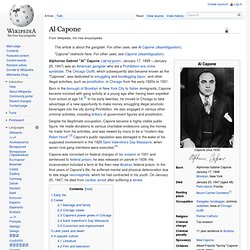
The Chicago Outfit, which subsequently also became known as the "Capones", was dedicated to smuggling and bootlegging liquor, and other illegal activities, such as prostitution, in Chicago from the early 1920s to 1931. Born in the borough of Brooklyn in New York City to Italian immigrants, Capone became involved with gang activity at a young age after having been expelled from school at age 14.[2] In his early twenties, he moved to Chicago to take advantage of a new opportunity to make money smuggling illegal alcoholic beverages into the city during Prohibition. He also engaged in various other criminal activities, including bribery of government figures and prostitution. Despite his illegitimate occupation, Capone became a highly visible public figure.
Early life. History Files - Al Capone. Al Capone Al Capone is America's best known gangster and the single greatest symbol of the collapse of law and order in the United States during the 1920s Prohibition era.

Capone had a leading role in the illegal activities that lent Chicago its reputation as a lawless city. Al Capone's mug shot, 1931. (CHS DN-91508) Capone was born on January 17, 1899, in Brooklyn, New York. In 1918, Capone met an Irish girl named Mary "Mae" Coughlin at a dance. Al Capone on Alcatraz. Capone had mastered the art of politics, and as a wealthy, powerful gangster figure, he attempted to balance his activities.

Despite his illegitimate occupation, he had become a highly visible public figure. He made daily trips to City Hall, opened soup kitchens to feed the poor, and even lobbied for milk bottle dating to ensure the safety of the city's children. City officials often were embarrassed by the politic strength of Capone, and began leveraging his illegal activities through police raids, along with setting intentional fires to his places of business. In the beginning, the public glamorized Capone's activities and identified with him as a modern day Robin Hood.
It wasn't long, however, before the public started weighing against him when it was believed that he had ordered the death of a famed local prosecutor named Billy McSwiggin. Capone quickly went into hiding, fearing he would be tried for McSwiggin's murder. Tax evasion. In contrast, tax avoidance is the legal use of tax laws to reduce one's tax burden.
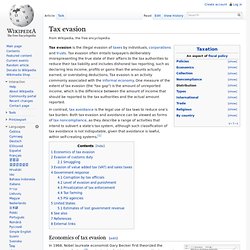
Both tax evasion and avoidance can be viewed as forms of tax noncompliance, as they describe a range of activities that intend to subvert a state's tax system, although such classification of tax avoidance is not indisputable, given that avoidance is lawful, within self-creating systems.[1] Economics of tax evasion[edit] The ratio of German assets in tax havens in relation to the total German GDP.[2] Havens in countries with tax information sharing allowing for compliance enforcement have been in decline. The "Big 7" shown are Hong Kong, Ireland, Lebanon, Liberia, Panama, Singapore, and Switzerland. In 1968, Nobel laureate economist Gary Becker first theorized the economics of crime,[3] on the basis of which authors M.G. The literature's theoretical models are elegant in their effort to identify the variables likely to affect non-compliance. Tax Fraud. Human trafficking. Human trafficking is the trade of humans, most commonly for the purpose of sexual slavery, forced labor or commercial sexual exploitation for the trafficker or others.[1][2] This may encompass providing a spouse in the context of forced marriage,[3][4][5] or the extraction of organs or tissues,[6][7] including for surrogacy and ova removal.[8] Human trafficking can occur within a country or trans-nationally.
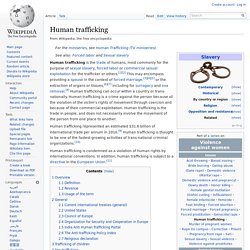
Human trafficking is a crime against the person because of the violation of the victim's rights of movement through coercion and because of their commercial exploitation. Human trafficking is the trade in people, and does not necessarily involve the movement of the person from one place to another. Human trafficking represented an estimated $31.6 billion of international trade per annum in 2010.[9] Human trafficking is thought to be one of the fastest-growing activities of trans-national criminal organizations.[10]
What is Human Trafficking? Gang. A gang is a group of recurrently associating individuals or close friends with identifiable leadership and internal organization, identifying with or claiming control over territory in a community, and engaging either individually or collectively in violent or other forms of illegal behavior.[2] Some criminal gang members are "jumped in" or have to prove their loyalty by committing acts such as theft or violence.
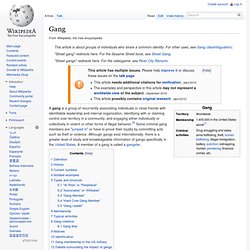
Although gangs exist internationally, there is a greater level of study and knowledgeable information of gangs specifically in the United States. A member of a gang is called a gangster. Definition[edit] Gangs are most prominent in larger cities and urban areas in many countries such as the United States, and in prisons and jails. Many branches of the original gang are also present in small towns and suburbs.
Gangs. Information on Los Solidos Gang. Second In A Series: Hartford, Gangs, and the Police. Second In A Series: Hartford, Gangs, and the Police The corner of Albany Avenue and Vine Street in Hartford has been ground zero for one of the city's more violent gangs, and over the past two years, the corner has been quieter.

But as WNPR’s Jeff Cohen reports in the second in a series on gangs in the city, that quiet was broken last week. Eleven-year-old Jimmy Ramsay and his cousin were going to pick up a friend and head to the Keney Park pool last Wednesday night. Mexican Drug War. The Mexican Drug War is an ongoing armed conflict among rival drug cartels fighting one another for regional control and against the Mexican government forces and civilian vigilante groups.

Since 2006, when intervention with the Mexican military began, the government's principal goal has been to put down the drug-related violence.[47] Additionally, the Mexican government has claimed that their primary focus is on dismantling the powerful drug cartels, rather than on preventing drug trafficking, which is left to U.S. functionaries.[48][49][50] Although Mexican drug cartels, or drug trafficking organizations, have existed for several decades, they have become more powerful since the demise of the Colombian Cali and Medellín cartels in the 1990s. Analysts estimate that wholesale earnings from illicit drug sales[clarification needed] range from $13.6 billion[51] to $49.4 billion annually.[51][56][57] Background[edit] Presidency of Vicente Fox[edit] Mexican Army Drug sources and use[edit] Crisantos Moroyoqui-Yocupicio, Accused Of Beheading Man Who Stole From Cartel, Pleads No Contest.
PHOENIX — A man has pleaded no contest to a murder charge in the beheading of a man in Arizona who police say had stolen drugs from a Mexican drug cartel.
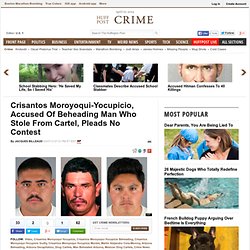
Crisantos Moroyoqui-Yocupicio, 39, made the plea Monday to second-degree murder in the death of 38-year-old Martin Alejandro Cota-Monroy at an apartment in the Phoenix suburb of Chandler on Oct. 10, 2010. Sentencing for Moroyoqui-Yocupicio, who faces 10 to 16 years in prison, is set for May 8. Police believe Cota-Monroy's gruesome killing was intended to send a message that anyone who betrays the traffickers will get the same treatment. The case has been cited as an extreme example of Mexican cartel violence spilling over the border. Mexico has been plagued by decapitations in the drug war against cartels. The Arizona beheading also factored into the state's contentious immigration debate.
Mexico’s drug war: 7 men shot in head are left in plastic chairs as 14 killed across 2 states. Terrorism. The word "terrorism" is politically loaded and emotionally charged,[6] and this greatly compounds the difficulty of providing a precise definition.
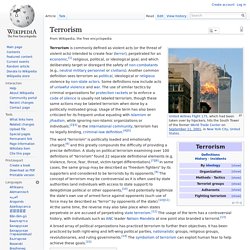
A study on political terrorism examining over 100 definitions of "terrorism" found 22 separate definitional elements (e.g. A broad array of political organizations has practiced terrorism to further their objectives. It has been practiced by both right-wing and left-wing political parties, nationalistic groups, religious groups, revolutionaries, and ruling governments.[14] The symbolism of terrorism can exploit human fear to help achieve these goals.[15] Origin of term[edit] "Terrorism" comes from the French word terrorisme,[16] and originally referred specifically to state terrorism as practiced by the French government during the 1793–1794 Reign of terror.
Cyberwarfare. Cyberwarfare refers to politically motivated hacking to conduct sabotage and espionage. It is a form of information warfare sometimes seen as analogous to conventional warfare.[1] Methods of attack[edit] Espionage and national security breaches[edit] Cyber espionage is the act or practice of obtaining secrets (sensitive, proprietary or classified information) from individuals, competitors, rivals, groups, governments and enemies also for military, political, or economic advantage using illegal exploitation methods on internet, networks, software and or computers.
Classified information that is not handled securely can be intercepted and even modified, making espionage possible from the other side of the world. Organized crime. 20th century American mobster Al Capone, a figure often associated with the topic of organized crime. Other organizations—including states, militaries, police forces, and corporations—may sometimes use organized crime methods to conduct their business, but their powers derive from their status as formal social institutions.